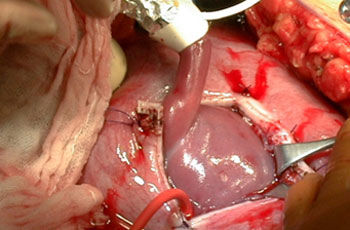Congenital cystic adenomatoid malformation (CCAM)
Problem
The term “congenital cystic adenomatoid malformation” (CCAM) refers to a number of different fetal malformations in which incorrectly formed lung tissue displaces and restricts the growth of normal lung tissue. These tumors differ in terms of their growth in that some remain the same size or even shrink, whereas others grow very rapidly and cause cardiovascular problems.
Diagnosis
These tumors are diagnosed by ultrasound. The illustration shows bright lung tissue (L) interspersed with black holes indicating the presence of cysts (C). Many such tumors and cysts continue to grow until the final quarter of pregnancy and thereafter remain constant in size.
Therapy
In most cases spontaneous delivery occurs and the newborn child requires no immediate treatment. Nevertheless, it is important to perform additional imaging (CT, MRI) at a later date so as to plan further action, such as an operation to remove the malformed lung tissue and thereby prevent lung infections and cancerous change. In rare cases the newborn child requires respiratory support. In such cases the investigations are brought forward so that any necessary operation can be performed promptly.
Outcome
Once this malformation has been removed the affected child generally has no disability and leads a normal life with no specific medical problems.





